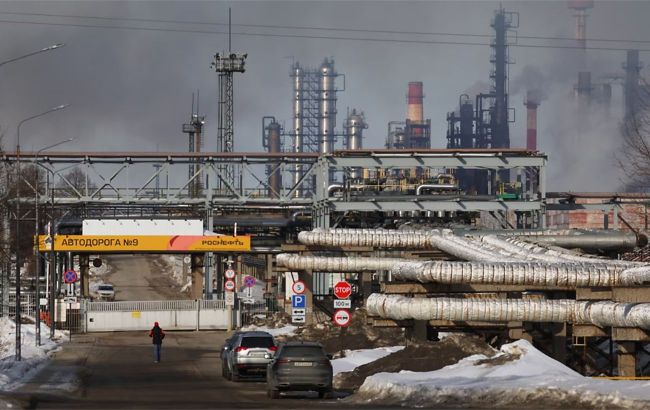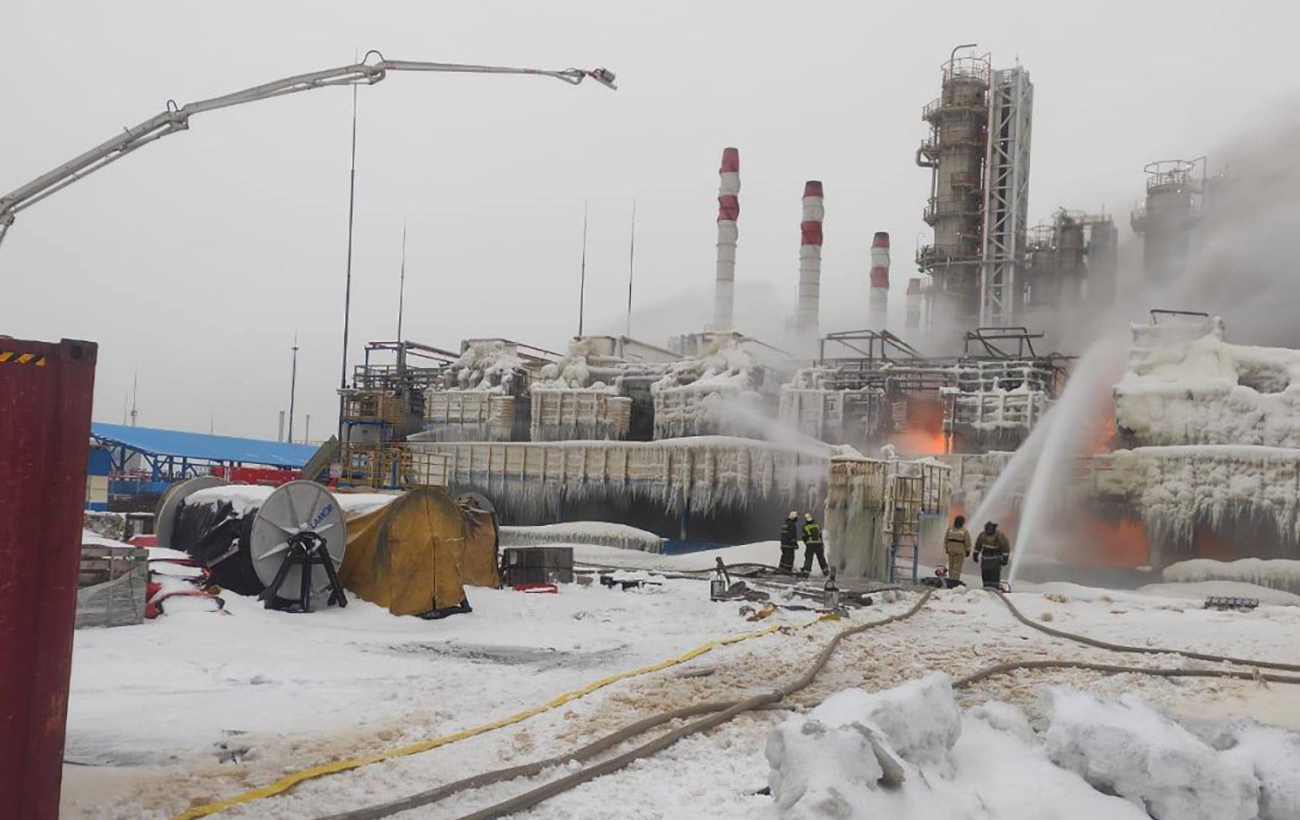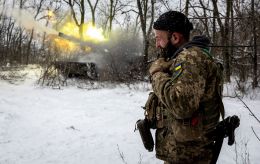Legitimate targets: Can strikes on oil refineries bleed Russia and aid Ukraine on frontline
 Smoke at the Ryazan oil refinery after the Ukrainian drone attack (photo by Russian media)
Smoke at the Ryazan oil refinery after the Ukrainian drone attack (photo by Russian media)
Ukraine has again attacked Russian oil refineries hundreds of kilometers from the border. Based on the dynamics, the attacks can already be called systematic, and this week, according to some estimates, they could have disabled more than 10% of Russia's facilities. Read more about why kamikaze drones are hitting oil refineries and whether this will affect the course of the Russian-Ukrainian war in RBC-Ukraine's article.
Sources used: Reuters, Bloomberg, Ukrainian portal Defense Express, Carnegie Endowment for International Peace, Russian Telegram channels, and comments by experts Vladyslav Seleznov and Hennadii Riabtsev.
Contents
- Russian refineries attacked by Ukraine
- Range of about 1000 km. What is known about drones striking targets in Russia
- Can strikes on refineries shake Russia's economy?
- Logistics and air defense. Can attacks on refineries affect battlefield?
Russian refineries attacked by Ukraine
This week, Ukraine attacked several refineries. According to a source in the Ukrainian Defense Forces, the attacks were part of a series of special operations launched by the Security Service of Ukraine.
"We are systematically implementing a well-calculated strategy to reduce Russia's economic potential. Our task is to deprive the enemy of resources and reduce the flow of oil money and fuel that Russia directs directly to the war and the killing of our citizens," he says.
These are attacks on refineries in Ryazan, Nizhny Novgorod, and Leningrad regions, which are among the top 5 Russian oil refineries. However, in recent days and weeks, Ukrainian drones have been hitting not only them.
Ryazan
The Ryazan Oil Refinery (Rosneft), according to the Telegram channels, was attacked by at least three drones, resulting in a fire. According to Reuters, two oil refining units had to be shut down - AVT-6 (47.5% of total capacity) and AVT-4 (23.4% of total capacity). According to estimates, up to 70% of the refinery's capacity may be idle for the repair period.
The refinery processes about 12.7 million tons of oil per year, accounting for 5.8% of Russia's refining. The distance from the Ukrainian border to Ryazan is about 450 km in a straight line.
Kirishi, Leningrad region
Kirishinefteorgsintez is controlled by Surgutneftegaz and is Russia's second-largest refinery. It processes about 17.7 million tons of oil per year or 6.4% of the total.
According to Reuters' industry sources, it produces 5.3% of Russia's gasoline, 7.6% of diesel, 16.3% of fuel oil, and 3.4% of jet fuel. Kirishi is located 800 kilometers from Ukraine. There are no confirmed reports of damage.
Kstovo, Nizhny Novgorod region
The fourth largest refinery in the region, NORSI (Lukoil), processes about 15.8 million tons of oil per year, or 5.8% of the total. The UAV strike damaged the main crude oil refining unit, AVT-6, which means that at least half of the production capacity has been shut down, Reuters reports.
Last year, this plant produced 11% of Russia's gasoline, 6.4% of diesel fuel, 5.6% of fuel oil, and 7.4% of jet fuel. Sources in the Ukrainian Defense Forces tell RBC-Ukraine that the attack was organized by the Defense Intelligence of Ukraine. The city of Kstovo is located 800 kilometers from Ukraine.
Novoshakhtinsk, Rostov region
On Wednesday, the Novoshakhtinsk oil products plant was shut down due to a drone attack. According to local authorities, the wreckage of a UAV fell on its territory. A representative of Ukrainian intelligence, Andrii Yusov, says that "a number of events" related to the military facilities of the aggressor country occurred at the plant. He also explains why the refinery should be targeted at all.
"Even though we are talking about the alleged Novoshakhtinsk oil refinery, it is a military facility used to supply and maintain the occupation group in Ukraine," he says.
 The Novoshakhtinsk oil refinery after one of the strikes (photo by Russian media)
The Novoshakhtinsk oil refinery after one of the strikes (photo by Russian media)
The Novoshakhtinsk refinery is located almost near the border with the occupied Luhansk region, about 150 km from the front line. It can be called a "pioneer" in attacks on such facilities. It was first attacked by drones in June 2022. Since then, Ukrainian forces have at least attacked the Ilsky, Afipsky, and Tuapse refineries in the Krasnodar Territory, as well as refineries in Yaroslavl and Volgograd.
Since these refineries supply fuel and lubricants for equipment at the front, these are legitimate targets. However, Vladyslav Seleznov, an expert and former spokesperson for the General Staff of the Armed Forces of Ukraine, doubts the expediency of the strikes and believes that the strikes at the refineries will not significantly affect the course of the Russian-Ukrainian war.
"This is being heavily covered in the media, but in terms of effectiveness, I think it is necessary to destroy the enemy's military potential first. Of course, the decisions are made by the military leadership, and the results we have are quite large-scale. The weakening of the components that ensure the combat power of the Russian army is great news, although even if we destroy 12% of oil refining (the figures from the Bloomberg publication below - ed.), enemy planes will not start flying less. There must be higher-priority targets for our kamikaze drones," he tells RBC-Ukraine.
Range of about 1000 km. What is known about drones striking targets in Russia
Long-range drones are being used to strike factories deep in the Russian rear. There is little information about which ones. In the summer, for example, it was reported that Moscow was attacked by Bober (beaver in Ukrainian - ed.) drones. They are also called the Ukrainian equivalent of Shahed drones. They are supposed to be capable of flying over 1,000 kilometers.
As for the strikes on the refineries, Russian public media reports that a long-range kamikaze drone, Liutyi (Fierce in Ukrainian - ed.), was allegedly involved in the attack on the Ryazan plant. Earlier, it was spotted during attacks on an aircraft plant in Taganrog and a metallurgical plant in Lipetsk.
This Ukrainian development is still shrouded in secrecy. Today, two parameters are known: a flight range of up to 1000 km and a warhead weight of 75 kg. Outwardly, the Liutyi resembles the Bayraktar TB2, but judging by the size of the engine, the drone is much smaller. This may be an intermediate version between the Bayraktar and the PD-2 from UkrSpecSystems.
 Model of the Ukrainian drone Liutyi (photo by facebook.com_anna.gvozdiar)
Model of the Ukrainian drone Liutyi (photo by facebook.com_anna.gvozdiar)
It was first shown in November 2023 as a model. At that time, Deputy Minister of Strategic Industries Hanna Hvozdiar published a photo of the model with the inscription "Liutyi", the number 02, and the Ukrainian coat of arms stylized as a bird.
Initially, it was stated that the Lyutyi would be a multi-purpose platform. It is not known whether this characteristic was realized in the end, or whether the UAVs remain disposable kamikazes, according to the Ukrainian portal Defense Express.
President Volodymyr Zelenskyy is pleased with the results. He recently said that he had received reports on the use of Ukrainian-made drones from the Armed Forces, the DIU, and the SSU.
"I think everyone can see that our drones are working. And they work long-range. Our long-range capability is a real approximation of security for everyone," he emphasizes.
The further Ukrainian drones can fly, the better, says Vladyslav Seleznov. However, he points to a pattern: the longer the range of a UAV, the more fuel it needs, the smaller its warhead, and, accordingly, the less destructive power.
"Long-range drones are quite large and therefore can be a relatively easy target for enemy air defense systems. It may be better to use shorter-range drones but in larger numbers. The production of long-range UAVs requires a lot of money, so I think it would be more appropriate to use other drones or to direct money to missile construction, because medium-range missiles, I think, will be a more rational approach in terms of striking enemy potential. Missiles are harder to shoot down and may be cheaper in mass production," the expert adds.
Can strikes on refineries shake Russia's economy?
Strikes on Russian refining have led to a rise in world oil prices. According to Reuters, on the evening of March 14, Brent futures exceeded $85 per barrel for the first time since November. This is how the market reacts to "growing geopolitical threats" in connection with the attacks by Ukrainian drones.
The problems of Russian oil refining have been highlighted since January. Back then, there were reports of a major malfunction at the Kstovo refinery near Nizhny Novgorod, an attack on the Ust-Luga oil terminal in the Baltic, and a plant in Tuapse. Logically, the question arose whether all this could shake Russia. Not only from the point of view that it exports about a third of its oil in the form of petroleum products. But from the point of view that refineries are important for the economy in general and for warfare in particular. After all, cars, tanks, and airplanes need to be fueled with gasoline, diesel, and kerosene, not crude oil.
The two refineries attacked in January were exporting and did not play a major role in the domestic market. But it is much more important that if Ukrainian drones hit from a thousand kilometers away, 18 refineries in the European part of Russia with a total capacity of 170 million tons per year could potentially be hit. This is more than half of the total volume, wrote Serhii Vakulenko, a research fellow at the Carnegie Endowment for International Peace.
In total, Russia has more than 30 large refineries and another 80 mini-refineries. Some of them, including the oil refining giant in Omsk, are beyond the reach of UAVs. At least for now. But even if Ukraine gets to all the refineries on the European side, it is pointless to hope that the aggressor's economy will collapse.
 Firefighters on the territory of the refinery in Kstovo after the attack on March 13 (photo by Russian media)
Firefighters on the territory of the refinery in Kstovo after the attack on March 13 (photo by Russian media)
"It seems as if people do not realize how difficult this task is. It's almost impossible to implement, and talking about how good drones will come and destroy a huge number of refineries is childishly ridiculous. Many people think that if you wave a magic wand, the Russian economy will collapse. It won't. I don't know how many more dozens of such hits are needed. And for every dozen, there will be 100 drones that will not reach the target, if not more," explains Hennadii Riabtsev, director of special projects at Psyche.
The February wave of attacks, according to Bloomberg, affected almost a fifth of Russia's facilities, which were restored by March. Nevertheless, the impact was significant, and on January 1, Russia imposed a six-month embargo on gasoline exports to stabilize domestic prices. The March attacks on the Ryazan, Kstovo, and Novoshakhtinsk refineries, according to the agency, could have affected at least 12% of the capacity. But this does not mean that they did.
According to Riabtsev, such an assessment would be objective if the drones had completely destroyed the installations at the above-mentioned refineries.
"But they are not destroyed. One hit to a crude oil refinery in Kstovo has been confirmed. There is also a suspicion that a similar one was hit in Ryazan," he says.
If the information about the Ryazan refinery is confirmed, the two facilities will process approximately 12 million tons per year. The total production of petroleum products in Russia is 280 million tons. Accordingly, we are talking about a possible loss of less than 5% of capacity.
"This is in case the Russians are unable to restore the refineries by the end of the year and do not increase production at other plants. Earlier, there was a hit to the catalytic cracker at the Volgograd refinery, and something hit the Tuapse refinery, I think it was an electric desalination unit. But this does not mean that the refineries are out of commission," Ryabtsev says.
On the other hand, oil refineries usually cost about $100 million. According to him, the Russians will not be able to restore the operation of the attacked refineries in full shortly, as the equipment is not manufactured in the Russian Federation and must be purchased. This will be a problem because there is a ban on the sale of equipment in Russia. Due to the same sanctions, repairs may take several months.
Logistics and air defense. Can attacks on refineries affect battlefield?
Theoretically, strikes on Russian refineries could lead to a reduction in tank fuel production capacity and revenues to finance the war (possibly by billions of dollars). It is too early to assess how drones will affect this. At least because the attacks are likely to intensify.
"The strikes to some extent reduce the revenues of the Russian budget, in particular, its military component. But I believe that our special services and other operators of long-range kamikaze drones should focus more on enemy airfields. It's much more important to turn planes that drop missiles and corrected bombs into a pile of scrap metal," says Seleznov.
According to him, he is close to the position of Austrian military analyst Tom Cooper. He doubts the value of strikes on oil refineries at a time when Russian aviation launches a hundred cruise missiles a day at the Ukrainian Defense Forces. Of course, the Ukrainians cannot act like the United States in the Persian Gulf, first destroying command centers and enemy air defense and then switching to Iraqi ground forces. However, the attacks on the refinery show that there are means to strike air bases around Ukraine, which have Su-24s, Su-30s, Su-34s, and Su-35s," he writes in a review.
 A fire at the terminal in Ust-Luga after the arrival of a drone in January (photo by Russian media)
A fire at the terminal in Ust-Luga after the arrival of a drone in January (photo by Russian media)
Seleznov also doubts that the attacks on the refineries will undermine Russian military logistics.
"There may be a delayed impact. However, Russia can change the direction of logistics. Experience has shown that the destruction of refineries on the Black Sea coast did not stop the supply of fuel for tanks in the south of Donetsk and Zaporizhzhia regions. I think that even the destruction of most of the refineries in the European part of the Russian Federation will not leave its army without fuel," emphasizes Seleznov.
At the same time, raids on rear facilities raise the issue of their security. The day before, Russian publicists reported that air defense divisions had been redeployed from the front to cover oil refineries.
"It seems to be a pure IPSO (information and psychological special operation - ed.) because there is no confirmation. It is unlikely that the enemy will remove air defense from the front. Do not assume that Russian generals are stupid. They are rational and use air defense systems to primarily cover military facilities," the expert adds.
The head of the Center for Military Legal Studies, Oleksandr Musiienko, expressed a similar opinion in a comment to RBC-Ukraine. According to him, the systematic strikes at Russian refineries do not mean that anti-aircraft missile systems will be transferred from the front.
Read more about this in the RBC-Ukraine article "Under Kremlin's nose: Role of drone attacks and border breaches in shifting war onto Russian soil."
***
Drone attacks are causing inconveniences for Russian oil refining, but not significant difficulties. Fires at refineries may have a propaganda effect, making Ukrainians happy, although there is no evidence of serious damage. Moscow tried to achieve something similar in the winter of 2022-2023 by attacking our energy sector. At first, there were big problems, but later Ukraine adapted and built up its air defense system, and the second winter of a full-scale war went off without blackouts. Perhaps it is Russia's turn to be tested.

